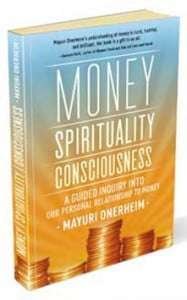What is Inquiry as a Spiritual Practice?
 My friend Mayuri has just published her first book – Money, Spirituality, Consciousness: a guided inquiry into our personal relationship to money.
My friend Mayuri has just published her first book – Money, Spirituality, Consciousness: a guided inquiry into our personal relationship to money.
Reading the first chapter, Why Inquiry? – resulted in a personal epiphany for me on an issue and exploration that has been going on for over 6 years around brilliancy and intelligence. It was a very cool experience.
I was reading the book on flight from Detroit to San Francisco – probably somewhere over Nebraska (though I don’t think that was a influence). It was like the heavens opened up or the Red Sea parted and there was a vision, an understanding of a question that I had spent many hours delving into. As I was drawn deeper into the vision/understanding, I very deep, deep space opened in my belly – an immense, endless space and I was at peace with myself in a way for the first time in my life. Everything, including me was simply fine as it is.
It was not anything specific in what Mayuri was saying in the book, but more a way that her simple explanation of inquiry as a spiritual practice landed in my mind that seemed to trigger the epiphany – a simple change in orientation or perspective that opened things up. In a way, a remembering of the simplicity and a letting go of the complexity that had built up over time.
Here is a small excerpt from the chapter on inquiry:
By watching any very young child, we can recognize how fundamental inquiry is to being human. And just as it is for that little one, our inquiry needs to be experiential. We make contact with what is happening inside ourselves, right where we are, as we are, by being present moment to moment with our experience. Doing inquiry—which we can define simply as an open and open-ended questioning of our experience that leads us to a living understanding of ourselves—is the most natural and simple thing in the world.
Inquiry will lead us to recognize that all of our reactions and negative emotions contain elements of unresolved past experiences, which color and even obscure our perception and don’t allow us to clearly see the world as it is. Until we can resolve those experiences through inquiry, we aren’t free to be an objective human being—that is, one who can appropriately respond rather than merely react. Thus, our journey is a matter of applying those same natural attributes of curiosity and openness that we had as children in order to see ourselves with more clarity now, so that we can wake up to what we are doing and how we are living. In moments of clarity, our consciousness is actually transformed. Over time, as more of those moments of awareness accumulate, we are transformed and become more of who we are. Ultimately, we have full access to our total potential, and we recognize directly the essence of who we are—which is the truth of our very Being.
Money, Spirituality, Consciousness is a must read for anyone who wrestles with the huge divide that seems to exist between money and spirituality.
[ad#post468]




